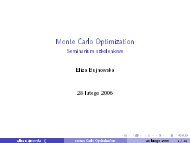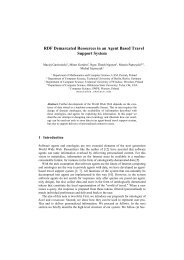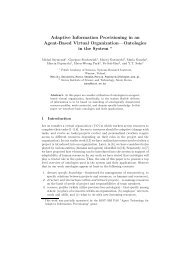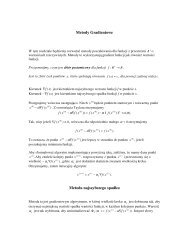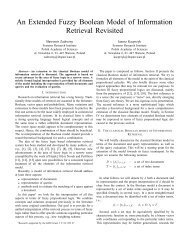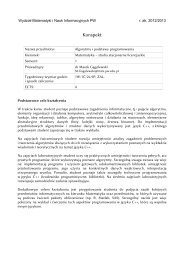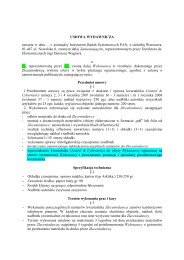<strong>Knowledge</strong> <strong>M<strong>an</strong>agement</strong> <strong>in</strong> <strong>an</strong> E-<strong>commerce</strong> <strong>System</strong> 10this. In general, the ma<strong>in</strong> goal of content personalization, as viewed from the e-<strong>commerce</strong> perspective, is to support theclient-system <strong>in</strong>teractions <strong>an</strong>d provide a quality substitute for the miss<strong>in</strong>g hum<strong>an</strong> salesperson. In particular, throughpersonalization the system aims at: provid<strong>in</strong>g a better quality of buy<strong>in</strong>g experience through underst<strong>an</strong>d<strong>in</strong>g <strong>an</strong>d predict<strong>in</strong>gneeds of <strong>in</strong>dividual customers, improvement of satisfaction of the customer, improved effectiveness of the system (asmeasured through the total number of items sold to each client), build<strong>in</strong>g of a br<strong>an</strong>d recognition <strong>an</strong>d a relationshipbetween clients <strong>an</strong>d e-stores, that will result <strong>in</strong> customer return<strong>in</strong>g <strong>an</strong>d mak<strong>in</strong>g additional purchases of commodities.Be<strong>in</strong>g able to directly <strong>in</strong>teract with the client <strong>an</strong>d track all of the <strong>in</strong>teractions (see Section 2), allows the system to get toknow the client <strong>an</strong>d to adjust the offer to her expectations. In addition it allows the system to <strong>in</strong>fluence her choices as wellas promote new products. An ontology designed for personalization comb<strong>in</strong>es knowledge about products <strong>an</strong>d associatedsale strategies comb<strong>in</strong>ed with knowledge of the customer <strong>in</strong> order to make relev<strong>an</strong>t suggestions. In addition, generalknowledge about products comb<strong>in</strong>ed with the <strong>an</strong>alysis of market trends <strong>an</strong>d client cluster<strong>in</strong>g allows the system to achievesuccess <strong>in</strong> deal<strong>in</strong>g with new clients. Summariz<strong>in</strong>g, the personalization eng<strong>in</strong>e perspective <strong>in</strong>corporates knowledge ofusers (described terms of populations, clusters <strong>an</strong>d <strong>in</strong>dividuals), sale strategies as well as supply dynamics.5.4 Org<strong>an</strong>izationalIn our earlier work <strong>an</strong>alyz<strong>in</strong>g abstractions of a real e-<strong>commerce</strong> system, we divided the functions of the system <strong>in</strong>tosupply support (SS) <strong>an</strong>d customer support (CS) subsystems, which <strong>in</strong>teract via a communication ch<strong>an</strong>nel [9]. Theknowledge m<strong>an</strong>agement of the system may be viewed similarly: the knowledge utilized by the supply subsystem islargely system knowledge, required for the support of tr<strong>an</strong>saction m<strong>an</strong>agement (buy<strong>in</strong>g <strong>an</strong>d sell<strong>in</strong>g) <strong>an</strong>d commoditym<strong>an</strong>agement (selection, delivery <strong>an</strong>d <strong>in</strong>ventory). The customer subsystem, on the other h<strong>an</strong>d, mimics the role of a hum<strong>an</strong>seller, support<strong>in</strong>g the customer <strong>in</strong> search<strong>in</strong>g, select<strong>in</strong>g <strong>an</strong>d purchas<strong>in</strong>g merch<strong>an</strong>dise [9]. These subsystems are largely<strong>an</strong>alogous to those found <strong>in</strong> well-established hum<strong>an</strong> org<strong>an</strong>izations: production <strong>an</strong>d development on one side <strong>an</strong>dmarket<strong>in</strong>g <strong>an</strong>d customer relations on the other.While knowledge about suppliers is mostly localized <strong>in</strong> the SS subsystem <strong>an</strong>d knowledge about customers is <strong>in</strong> theCS subsystem, the two spheres are <strong>in</strong>terdependent. The success of <strong>an</strong>y form of <strong>commerce</strong> lies <strong>in</strong> the reconciliation ofcustomer <strong>in</strong>terests with bus<strong>in</strong>ess objectives, <strong>an</strong>d e-<strong>commerce</strong> is no different <strong>in</strong> this sense. Consider that one of the goalsof the supply system is to sell the commodity it has the most of (<strong>in</strong> order to reduce <strong>in</strong>ventory) as well as the products thatare most profitable. This knowledge of products must be tr<strong>an</strong>sferred to the CS subsystem so that these products c<strong>an</strong> bepromoted, particularly to a target base of customers who are more likely to purchase them. On the other h<strong>an</strong>d, the supplysystem must const<strong>an</strong>tly accept feedback from the customer support system, <strong>in</strong> order to match the supply of a product toits dem<strong>an</strong>d. Similarly, a customer may have <strong>in</strong>dividual desires, which are not satisfied by a general selection ofcommodities, <strong>an</strong>d these must also be taken <strong>in</strong>to account by the supply system. <strong>Knowledge</strong> of this customer <strong>an</strong>d hisexpectations are crucial to both the CS <strong>an</strong>d SS subsystems – “the customer is always right” still applies to e-<strong>commerce</strong>,<strong>an</strong>d <strong>in</strong> fact it is even more import<strong>an</strong>t because of the customer’s additional expectations. F<strong>in</strong>ally, knowledge of the outsideworld is pert<strong>in</strong>ent to both subsystems: the system must function realistically (as described above) as well as follow trends<strong>an</strong>d other <strong>in</strong>formation that is not mediated through the customer <strong>an</strong>d supply sides. An ontology for the CS-SS modelsencompasses knowledge from hum<strong>an</strong> m<strong>an</strong>agement experts, product pl<strong>an</strong>ners <strong>an</strong>d supply-side coord<strong>in</strong>ators as well as thatfrom customers relations specialists. It also <strong>in</strong>cludes knowledge describ<strong>in</strong>g the <strong>in</strong>ternal processes of successfulorg<strong>an</strong>izations, from <strong>an</strong>d upon which the system may adapt <strong>an</strong>d grow through its cont<strong>in</strong>ual operation <strong>in</strong> the market.5.5 Customer support strategiesThis ontology subsumes that of personalization, <strong>an</strong>d references the entirety of knowledge necessary for serv<strong>in</strong>gcustomers. Thus there is some overlap with the economic, org<strong>an</strong>izational <strong>an</strong>d multiple other ontologies that relate toknowledge of customer support. Here the e-<strong>commerce</strong> system is perceived as a me<strong>an</strong>s to the end of customer satisfaction– “the customer is always right” – <strong>an</strong>d we consider m<strong>an</strong>y qualifications for this, for <strong>in</strong>st<strong>an</strong>ce:- <strong>in</strong>teraction with the system (easy to use, aesthetically pleas<strong>in</strong>g),- r<strong>an</strong>ge of commodities offered,- quality of service – timel<strong>in</strong>ess, returns, responsiveness to feedback, etc.,International Conference on Electronic Commerce Research (ICECR-5)
<strong>Knowledge</strong> <strong>M<strong>an</strong>agement</strong> <strong>in</strong> <strong>an</strong> E-<strong>commerce</strong> <strong>System</strong> 11- guar<strong>an</strong>tees of customer privacy,- convenient forms of payment,- the system’s behavior when a product is out of stock,as well as other service-oriented aspects, while still keep<strong>in</strong>g <strong>in</strong> m<strong>in</strong>d the profit goals of the enterprise. Thus the strategy ofthis perspective is “sell what you c<strong>an</strong> to <strong>an</strong>yone you c<strong>an</strong>.” It is impossible to only address customer needs <strong>an</strong>dexpectations; the bus<strong>in</strong>ess perspective has to be taken <strong>in</strong>to account as well. Customer support strategies have to strike abal<strong>an</strong>ce between the goals of the system <strong>an</strong>d the customer.5.6 <strong>Knowledge</strong> spacesThis implementation-level ontology categorizes knowledge created from <strong>in</strong>formation sources <strong>an</strong>d hum<strong>an</strong> experts <strong>in</strong>toknowledge about users, knowledge about the system <strong>an</strong>d knowledge about the environment <strong>in</strong> which the system resides.These are spheres of knowledge, knowledge spaces, <strong>an</strong>d are closely related to <strong>an</strong>d structured accord<strong>in</strong>g to the orig<strong>in</strong>alsources, which the referred-to knowledge is acquired from. <strong>Knowledge</strong> created from <strong>in</strong>teractions with users falls <strong>in</strong> to theuser sphere, while knowledge concern<strong>in</strong>g the system’s operation as <strong>an</strong> enterprise (<strong>in</strong>clud<strong>in</strong>g supply support) resides <strong>in</strong> thesystem sphere. <strong>Knowledge</strong> derived from the outside world is <strong>in</strong> the environment sphere. <strong>Knowledge</strong> about users is fairlyeasy to def<strong>in</strong>e (though not so easy to gather): who the users are, what they like <strong>an</strong>d dislike, how they employ the system,etc. <strong>Knowledge</strong> about the system is much broader, <strong>an</strong>d <strong>in</strong>cludes knowledge of: current <strong>an</strong>d potential products offered bythe system, suppliers of those products, the system’s bus<strong>in</strong>ess models <strong>an</strong>d operat<strong>in</strong>g parameters <strong>an</strong>d other categoriesrelated to the e-<strong>commerce</strong> system’s role <strong>in</strong> the environment. <strong>Knowledge</strong> <strong>in</strong> the environment is everyth<strong>in</strong>g that is externalto the system, but must still be known to it; the system does not exist <strong>in</strong> a void, <strong>an</strong>d if it is to succeed it must be “aware”of what of the world <strong>in</strong> which it operates. This requires knowledge of the theoretical (such as the basic laws of economy)to the practical (network outages).The knowledge space ontology divides the functions of the e-<strong>commerce</strong> system <strong>an</strong>d associated knowledge at a verylow level, <strong>an</strong>d thus it is especially useful <strong>in</strong> implementation. Components that operate <strong>in</strong> the user sphere <strong>in</strong>teract witheach other <strong>in</strong> a common doma<strong>in</strong>, while components deal<strong>in</strong>g with the environment sphere may be configured as a “wall”around the system. In addition, there are l<strong>in</strong>ks between the spheres <strong>in</strong> the form of components whose work<strong>in</strong>g ontologiesrefer to portions of multiple spheres.5.8 Dynamics of ch<strong>an</strong>geOne of the most import<strong>an</strong>t considerations <strong>in</strong> m<strong>an</strong>ag<strong>in</strong>g knowledge <strong>in</strong> a near real-time environment such as <strong>an</strong> e-<strong>commerce</strong>system is time dependence. From this perspective <strong>an</strong> ontology may be def<strong>in</strong>ed which divides knowledge <strong>in</strong>to const<strong>an</strong>t,slowly-ch<strong>an</strong>g<strong>in</strong>g <strong>an</strong>d fast-ch<strong>an</strong>g<strong>in</strong>g knowledge. This ontology may be correlated with the empirical-model-situationalontology, <strong>in</strong> identify<strong>in</strong>g const<strong>an</strong>t knowledge as empirical knowledge, slow-ch<strong>an</strong>g<strong>in</strong>g knowledge as model knowledge <strong>an</strong>dsituational knowledge as fast-ch<strong>an</strong>g<strong>in</strong>g knowledge. The correlation is not exact, of course. Fast-ch<strong>an</strong>g<strong>in</strong>g knowledge<strong>in</strong>cludes most knowledge derived from user <strong>in</strong>teractions, but may describe knowledge which was, from the hum<strong>an</strong>perspective, identified as empirical. The time-dependency categorizations are very fuzzy, because situations may arise <strong>in</strong>which const<strong>an</strong>t knowledge may require modification on the basis of fast-ch<strong>an</strong>g<strong>in</strong>g or slow-ch<strong>an</strong>g<strong>in</strong>g, model-typeknowledge. Such a shift would describe the ch<strong>an</strong>ge <strong>in</strong> th<strong>in</strong>k<strong>in</strong>g before <strong>an</strong>d after the large-scale development of theInternet as a commercial doma<strong>in</strong>. The time-m<strong>an</strong>agement functions of the system may be localized <strong>in</strong> <strong>an</strong> <strong>in</strong>dividualcomponent that “watches” for ch<strong>an</strong>ges <strong>an</strong>d <strong>in</strong>terruptions of this nature, or it may be <strong>in</strong>tegrated <strong>in</strong>to each of the exist<strong>in</strong>groles. The purpose of this ontology is to make the system “aware” of time <strong>an</strong>d the dynamics of ch<strong>an</strong>ge <strong>in</strong> the knowledgefeedback loop, so that the system does not get “stuck” or become outmoded.5.9 <strong>Knowledge</strong> tr<strong>an</strong>sfer (flow)In addition to the established, role-attached perspectives on knowledge with<strong>in</strong> the system, there is the view of knowledgeas a tr<strong>an</strong>sferable qu<strong>an</strong>tity. Here low-level knowledge is the modicum of exch<strong>an</strong>ge between knowledge entities.International Conference on Electronic Commerce Research (ICECR-5)



